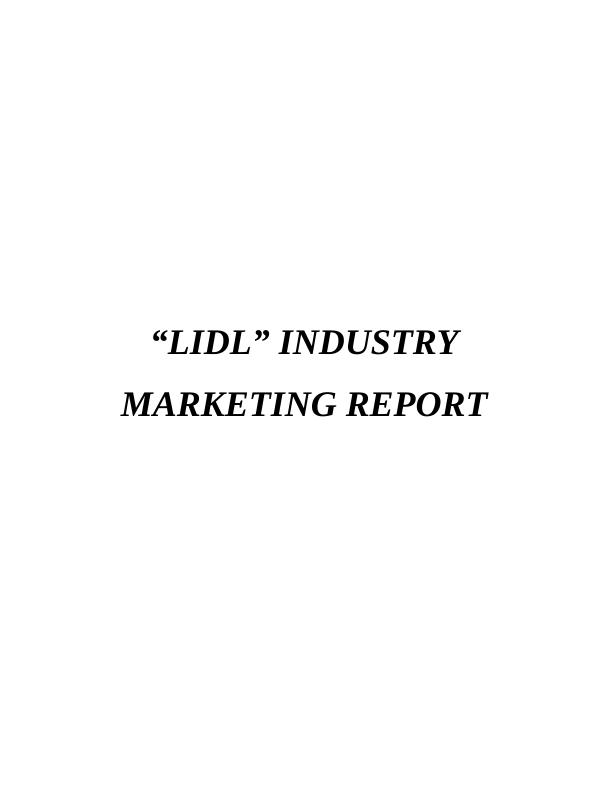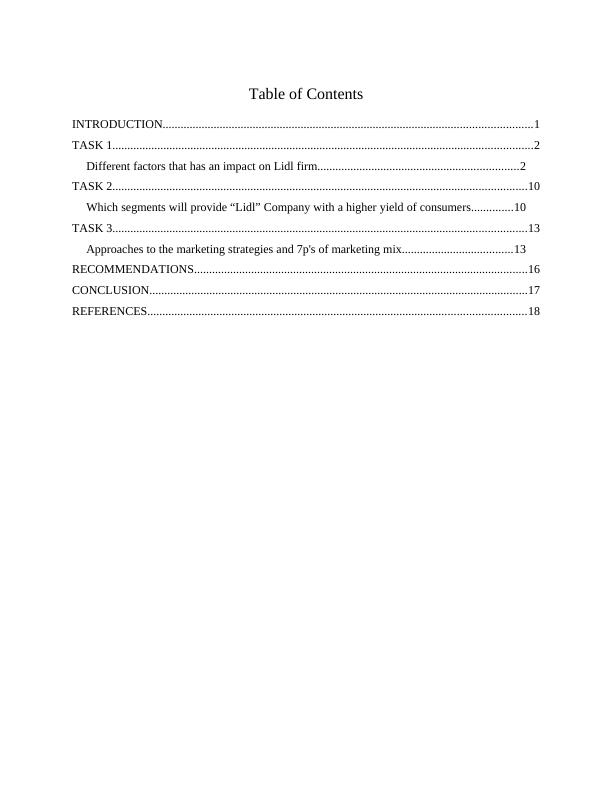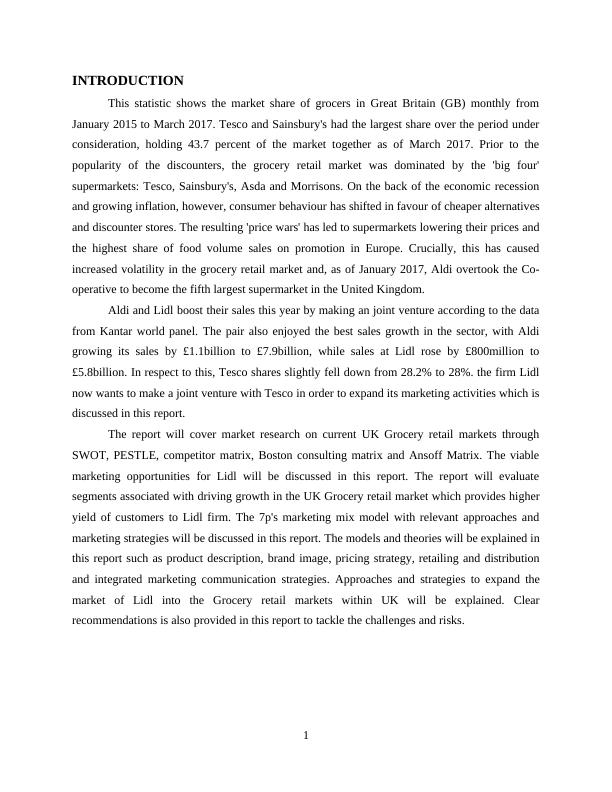“LIDL” Industry Marketing Report
Added on 2020-07-22
22 Pages6469 Words640 Views
“LIDL” INDUSTRYMARKETING REPORT

Table of ContentsINTRODUCTION...........................................................................................................................1TASK 1............................................................................................................................................2Different factors that has an impact on Lidl firm...................................................................2TASK 2..........................................................................................................................................10Which segments will provide “Lidl” Company with a higher yield of consumers..............10TASK 3..........................................................................................................................................13Approaches to the marketing strategies and 7p's of marketing mix.....................................13RECOMMENDATIONS...............................................................................................................16CONCLUSION..............................................................................................................................17REFERENCES..............................................................................................................................18

INTRODUCTIONThis statistic shows the market share of grocers in Great Britain (GB) monthly fromJanuary 2015 to March 2017. Tesco and Sainsbury's had the largest share over the period underconsideration, holding 43.7 percent of the market together as of March 2017. Prior to thepopularity of the discounters, the grocery retail market was dominated by the 'big four'supermarkets: Tesco, Sainsbury's, Asda and Morrisons. On the back of the economic recessionand growing inflation, however, consumer behaviour has shifted in favour of cheaper alternativesand discounter stores. The resulting 'price wars' has led to supermarkets lowering their prices andthe highest share of food volume sales on promotion in Europe. Crucially, this has causedincreased volatility in the grocery retail market and, as of January 2017, Aldi overtook the Co-operative to become the fifth largest supermarket in the United Kingdom.Aldi and Lidl boost their sales this year by making an joint venture according to the datafrom Kantar world panel. The pair also enjoyed the best sales growth in the sector, with Aldigrowing its sales by £1.1billion to £7.9billion, while sales at Lidl rose by £800million to£5.8billion. In respect to this, Tesco shares slightly fell down from 28.2% to 28%. the firm Lidlnow wants to make a joint venture with Tesco in order to expand its marketing activities which isdiscussed in this report.The report will cover market research on current UK Grocery retail markets throughSWOT, PESTLE, competitor matrix, Boston consulting matrix and Ansoff Matrix. The viablemarketing opportunities for Lidl will be discussed in this report. The report will evaluatesegments associated with driving growth in the UK Grocery retail market which provides higheryield of customers to Lidl firm. The 7p's marketing mix model with relevant approaches andmarketing strategies will be discussed in this report. The models and theories will be explained inthis report such as product description, brand image, pricing strategy, retailing and distributionand integrated marketing communication strategies. Approaches and strategies to expand themarket of Lidl into the Grocery retail markets within UK will be explained. Clearrecommendations is also provided in this report to tackle the challenges and risks.1

TASK 1Different factors that has an impact on Lidl firmGD expects the UK grocery market to be worth £179.1bn in 2016, an increase of 0.6% on2015. The forecast says that the UK grocery market value will be worth £196.9bn in 2021, a9.9% increase on 2016. The grocery market accounts for 50.2p in every £1 of UK retail sales.The statistical indicators of UK Grocery retail marketing shows that the total sales isincreased year by year that market is going good in terms of profitability and production (Amosand Sullivan, 2017). The UK market is in very good condition towards Grocery retail firms thatTesco, Sainsbury, Lidl and Morrison are going good and increasing their sales and profitsconsistently. SWOT analysis of LidlStrengths: Lidl firm was founded in 1973 and it is one of the leading food Groceryretailer business within UK, Europe. The firm is doing business in UK since 1994 andbecome the 7th largest supermarket chain with 5.2% market share effectively. The firmhas now 650 stores and employee around 20,000 with 10 distribution centres. The firm isalso known as a discounter that it is committed towards customers in order to provide2Illustration 1: UK Grocery retailingSource: UK market and channel forecasts 2016 - 2021

effective and quality products and services to them. The firm is mainly focused onmaking local products. For an example, 70% products of the firm are offered in UK andcome from British suppliers. Weaknesses: The firm has small number of employees as compared to the other firmsfrom same sector. Employees are less than expectations that few people are there to assistcustomers in stores regarding queries (BĂLĂŞESCU, 2015). Du to some controversiesthe reputation of firm is in a danger. For instance, the company was accused of spying onits employees across Germany in 2008. Spying included but not limited to recording thenumber of times employees went to the toilet, and their very personal details.Opportunities: The firm has currently 10,000 stores in 27 European nations. Thus, thereare some potential areas available for firm to expand their business and operationalactivities. In fact the firm is the fastest growing firm in Grocery retail sector andsupermarket chains within UK. Lidl has opportunity to develop its business in the USAalso. The plan is to open 600 new store in country that Tesco failed in US to expand itsbusiness. Lidl should take some initial steps in order to expand its activities in US.Threats: The most annoying threat for Lidl is number of competitors available inmarkets such as Sainsbury, Tesco, Morrison and Aldi. Competitors in UK Tesco,Morrison and Sainsbury where Aldi in Europe leading the competition. Changes inconsumer behaviour, and any political instability in Europe may impact on Lidlsignificantly. It may sound harsh; however, any increase in minimum wages may alsoimpact on the company profitability effectively and efficiently. PESTLE analysis of LidlPolitical: Political factor is the first aspect of PESTLE analysis. Some political examplesshould be managed and controlled by firm in order to manage its business operations over10,000 store in Europe (Daniel, 2015). Natural assurance law is one of the majorcomponents which is affecting the business and operational activities of Lidl. The firmshould comply with all the government needs in order to run business successfully andeffectively. The UK government vitality advance program to do work of retail productsand services innovatively is also affecting the business. Economical: Lild uses economical factors such as internal and external. There are manyrules and regulations formulated by the government and associated with retail firms in3

order to develop and improve the level of economy effectively. Consequently,recuperation of GDP and the rising rate in the majority of the slowly developing nationsfrom the recessionary period that happened in 2008/2009 has a huge effect on the clientbuying power. The firm also has a stable financial system that enables it to communicateeffectively and favourably.Social: Social factors also affect the business of Lidl that social components areevaluated with natural expansion concern, stress and mentality on products (de Oña andde Oña, 2015). People living in the societies are the most important part that they shouldaccept products and services offered by firm in the market. The company has alsoconsidered a number of cultural elements that help in achievement of competitiveadvantage and in promotion of customer interests. For instance, the company stocksvarious items used by almost all the religions in Europe.Technological: It can be said that the technology is increasing day by day in any sector.The firm should use latest innovations and techniques in order to improve customerservice. In addition to this, some technical devices should be used such as credit cardmachine for cash less transactions and make purchasing easier and faster. Legal: Legal factors are related to the policies, strategies, plans and changes made bygovernment which affects the business operational activities of Lidl effectively. Healthand safety, employees obligations and other different laws and legislations regardingretail industries. Such legal factors should be analysed and followed well in order to runbusiness smoothly and effectively.Environmental: Environmental factors such as population analysis, choices, culture andtrends (Formánková, Chládková and Hanusová, 2015). Europe, USA and UK are thecountries where the preferences and perception of customers are different that the firmshould determine requirements and demands of customers towards products and services.This will help them to increase its competitive advantage and will also enhance sales andprofitability effectively.4

End of preview
Want to access all the pages? Upload your documents or become a member.
Related Documents
Report on Research UK Grocery and Retail Marketlg...
|22
|6181
|89
Introduction of Marketing of Retail Sector - Reportlg...
|21
|6569
|430
Case Study: Offline, Online and Back - The Evolution of the UK Grocery Marketlg...
|10
|3223
|83
Financial Statement Analysislg...
|15
|3141
|424
Marketing Strategy of Lidllg...
|16
|6203
|108
Analysis of Tesco's Cost Leadership Strategy and Market Positionlg...
|10
|3240
|81
